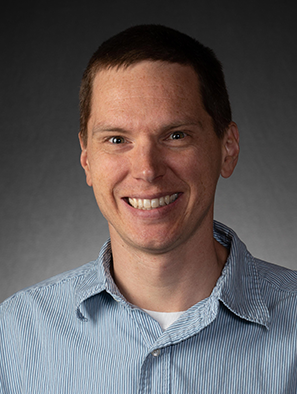
Mark Siemens
Professor; Chair
Physics Building, 2112 E. Wesley Ave. Denver, CO 80208
What I do
"Curiosity in community" is the best environment for both rich learning and innovative research.Specialization(s)
condensed matter physics, Optics and Photonics
Professional Biography
Dr. Mark Siemens received a B.S. in Engineering Physics from the Colorado School of Mines in 2003 and did his Ph.D. research at JILA and the University of Colorado. After graduating in 2009, Dr. Siemens worked as an NRC postdoc at the National Institute of Standards and Technology (NIST) and JILA. In 2010, he moved to the University of Denver where he joined the Department of Physics and Astronomy as an Assistant Professor. He was promoted to Associate Professor in 2016 and was appointed Director of the Undergraduate Research Center in 2018. Dr. Siemens has two primary research interests: 1.) Using ultrashort laser pulses to measure electron transport in semiconductors for making better solar cells, and 2.) Studying topological effects in laser beams with orbital angular momentum.
Degree(s)
- Ph.D., Physics, University of Colorado, 2009
- BS, Engineering Physics, Colorado School of Mines, 2003
Professional Affiliations
- The Optical Society
- American Physical Society
Research
The Siemens group has two primary research interests: ultrafast spectroscopy and topological optics.
We use ultrashort pulsed lasers to control and measure electron transport, primarily through multidimensional coherent spectroscopy. This allows us to observe and differentiate coherent and incoherent transport pathways in complex semiconductor materials such as quantum wells and thin films. We are currently studying perovskite thin films, which have shown great promise as a next-generation photovoltaic material without clear understanding of why they work so well - our goal is to clarify the basic transport physics in these materials to enable the fabrication of even higher conversion efficiency and lower cost solar cells.
We also study the generation, propagation, and measurement of light with phase singularities and orbital angular momentum (OAM). We are interested in high-purity generation and high-fidelity measurement of light's OAM for potential applications in communication and spectroscopy. We are studying emergent topological interactions in propagating optical beams.
We use ultrashort pulsed lasers to control and measure electron transport, primarily through multidimensional coherent spectroscopy. This allows us to observe and differentiate coherent and incoherent transport pathways in complex semiconductor materials such as quantum wells and thin films. We are currently studying perovskite thin films, which have shown great promise as a next-generation photovoltaic material without clear understanding of why they work so well - our goal is to clarify the basic transport physics in these materials to enable the fabrication of even higher conversion efficiency and lower cost solar cells.
We also study the generation, propagation, and measurement of light with phase singularities and orbital angular momentum (OAM). We are interested in high-purity generation and high-fidelity measurement of light's OAM for potential applications in communication and spectroscopy. We are studying emergent topological interactions in propagating optical beams.
Areas of Research
Ultrafast optics
Light-matter interactions
Nanoscale transport
Multidimensional coherent spectroscopy
Topological optics
Photonic orbital angular momentum
Key Projects
- CAREER: Unlocking forbidden optical transitions in nanostructures using light with orbital angular momentum
- Collaborative Research: OAM photonics: sensing and imaging enabled by orbital angular momentum of light
- Collaborative: Ultrafast Phonon Spectroscopy for Lifetime Measurements of Phonons in 2-D Transitional Metal Dchalcogenides
- Quanitzed phonon dynamics for thermoelectrics
Featured Publications
. (2017). Angular Momentum of Topologically Structured Darkness. Physical Review Letters, 119, 203902.
. (2017). Localization dynamics of excitons in disordered semiconductor quantum wells. Physical Review B, 95, 235307.
. (2016). Quantitative measurement of the orbital angular momentum of light with a single, stationary lens. Optics Letters.
Presentations
. (2018). A taste of research. All-Campus Lectures 2018. University of Denver.
. (2018). Angular Momentum in Fractional Vortex Beams of Light. OSA Incubator meeting on Optical Orbital Angular Momentum. Washington DC: Optical Society of America.
. (2018). Angular Momentum Contribution of Topologically Structured Darkness. OSA Quantum Electronics and Laser Science (CLEO/QELS). San Jose, CU.
. (2018). Natural Lineshapes by Projecting Multidimensional Spectra. OSA Quantum Electronics and Laser Science (CLEO/QELS). San Jose, CU.
. (2018). Stimulated emission depletion microscopy with polarization-maintaining fiber. OSA Quantum Electronics and Laser Science (CLEO/QELS). San Jose, CU.
Awards
- Fulbright Scholar, Fulbright Scholar program, United States Department of State Bureau of Educational and Cultural Affairs
- Franklin Research Grant , American Philosophical Society
- NSF CAREER award, National Science Foundation
- Outstanding Junior Faculty, DU Division of Natural Sciences & Mathematics
- Doctoral New Investigator, American Chemical Society


